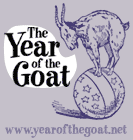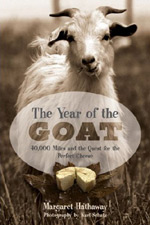 |
| Ruble Conatser brings out a stack of 'Eat More Goat' bumper stickers at The Mountain Goat Ranch in Jamestown, Tennessee |
Until we talked to Ruble Conatser, Karl and I had never heard of the Kiko goat. Our meat goat experience was limited to Boers and to dairy and fiber culls, and though we knew that much of the goat meat consumed in America was imported from New Zealand, we had no idea what sort of animal those goats were. As it turns out, they are Kiko goats, a majestic-looking breed, with a shaggy coat and expansive horns. The Kiko, like the Boer, has recently been introduced to the American goat farmer. Unlike the Boer, however, Kikos are not show animals. They are bred solely for production, and the American Kiko Goat Association (AKGA), of which Ruble is the current President, has no sanctioned shows. While Kikos are very attractive animals, they are raised for one purpose: meat.
The more we read about Kikos, the more interesting we found them. We're not sure why, but a good Kiko buck is significantly cheaper than a top of the line animal from any other breed. Also, since they were bred in the relatively damp climate of New Zealand, their genetics have evolved to ward off parasites and fungus, which makes them ideal for a wide range of climates, including Eastern Tennessee, where Ruble's Mountain Goat Ranch is located.
 |
| Ground goat meat in the freezer at the future home of Mountain Vittles, inc. |
We were a little early to our meeting with Ruble, but when he pulled up in his truck — license plate: EATGOAT — he immediately hopped down with presents for us. A true promoter of goat meat, he handed us red baseball hats with the Mountain Goat Ranch logo on them, bumper stickers which read "Eat More Goat," and later gave us samples of his Horny Goat Jerky. The jerky, which is still in its early stages of development, should be on the market next year, but in the meantime Ruble has teamed up with a Grade A meat processing plant, which packages goat meat under his label. He only slaughters wethers and does, since bucks have a distinctive goaty flavor, and he has the meat butchered into the same cuts that are most popular in beef. Though there's not much market yet for goat meat in his area (the one Jamestown restaurant that carried goat burgers is under new management), since the meat is Grade A, it can be shipped throughout the United States.
After a tour of the ranch and introductions to his many dogs and goats, Ruble took us over to the nearly complete Mountain Vittles building, which will house the jerky business. There, he loaded us up with frozen goat steaks and patties, and then, knowing that we were camping in the Big South Fork National Recreation Area and would be cooking over a camp stove, invited us to stay for a tasty chicken-fried-goat supper with his family.
The incredible Southern hospitality aside, what impressed us most about Ruble were his marketing efforts. Though a lot of meat goat farmers are reaching out to ethnic markets, we've only met a few who are trying to introduce goat meat to a mainstream audience. Ruble, with both his meat and his jerky, is working tirelessly to advance goat as simply an alternative red meat. Without a powerful goat council to launch an ad campaign, this may be tricky to accomplish, but we think it's well worth it. —MMH
 |
| Kiko goats graze in the pasture at Mountain Goat Ranch |




